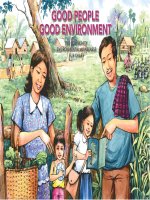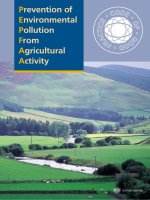Good People Good Enviroment
Bạn đang xem bản rút gọn của tài liệu. Xem và tải ngay bản đầy đủ của tài liệu tại đây (4.76 MB, 37 trang )
1. ABOUT THE FLIP CHART:
This flipchart is accompanied by a facilitator’s guide which details the process for
setting up, organising and holding an effective group meeting. You should also
read and familiarize yourself with the entire flipchart prior to using it.
The facilitators contains a glossary which can explain environmental terms and
also a list of NGOs, who can provide additional support for the community. These
contact details can be passed onto the community.
The pages are divided into five modules, each module is designed to take 2-3
hours. The recommended way to use it is to work through the whole flipchart,
starting from module 1 to module 5 but if there are time constraints, modules can
be worked on individually.
• On the front of each page is the illustration with its TITLE, visible so the group
can find a context for the discussion.
• On the back of the pages is a BACKGROUND FOR FACILITATORS, which
provides you (the facilitator) with information to support the discussion. You may
want to use some of these facts in your discussions, but do not just read this text
out. Also on the back of pages are the DISCUSSION POINTS which you should
read out to stimulate discussion.
• Each module includes an ACTIVITY. This is designed to break up the talking
with a little action. This can be very useful in maintaining the attention of the
group and should be fun.
PAGE 1 – INTRODUCTION
OBJECTIVE
To give the participants an overview of the flipchart approach.
GUIDELINES FOR FACILITATOR
INTRODUCTION POINTS
A.
Welcome the participants and thank them for attending.
B. Introduce yourself and others in your team to the group
then conduct the Web of Life activity, as listed on this page.
C. Explain to the group the objectives of the flip chart.
D. You should set an agenda for each module, outlining
the topic/s you will cover and the time that you intend to
start, break, finish. This should be planned for the entire
approach and repeated at the beginning and end of each
module.
E. Tell the participants about the flipchart approach - i.e.
there is a large picture on one side and discussion points
and information on the back to assist facilitation.
F. Explain the entire flipchart process
(i.e. 5 modules and the
themes for these modules.The pages are grouped into related topic
sections (modules). Each module should take roughly 2-3 hours to
discuss. An action plan will be written up at the end of each module.
At the end of all modules is a Review and final action plan)
The themes for each module are as follows:
MODULE 1
Page 1. Introduction
Page 2. A Bad Environment
Page 3. A Better Environment
MODULE 2
Page 4. Water cycle
Page 5. Water and sanitation issues
Page 6. Good water and sanitation
approaches
Page 7. Nutrition
MODULE 3
Page 8. Pollution
Page 9. Waste management
Page10. Chemical alternatives
MODULE 4
Page 11. Good and bad fishing
practices
Page 12. Importance of wetlands
Page 13. Illegal wildlife hunting and
Trading
Page 14. Importance of forests
MODULE 5
Page 15. Protected areasProtected areas
Page 16. Tonle Sap BiosphereTonle Sap Biosphere
Reserve
Page 17. Mondulkiri forestMondulkiri forest
Page 18. Review and final actions
!
A c t i v i t y –
W E B O F L I F E
Name villagers as different animals and plants found in the appropriate
ecosystem. A ball of string is held by the participants who are plants, then
passed onto animals that eat plants, then onto animals that eat both plants
and animal and then to animals that eat other animals Let the villagers decide
which organisms interact with each other. The group can see what the effects
on the ecosystem are when ‘animal or plant (person) is removed.
MODULE
1
Issues Actions People
Responsible
• At the end of each module is an ACTION
PLAN. The aim of this ACTION PLAN
is to encourage participants to move
towards making positive changes in their
community relevant to the subjects in
that module.
This ACTION PLAN requires the
facilitator to pin up a large sheet of
paper, separated into three columns
labeled: 1. ISSUES, 2. ACTION and 3.
People responsible. (see left)
At the end of each module, the group
should list the 4 most important issues
in their community (relevant to that
particular module), and write actions to
address these issues. They should then
choose a person who will be responsible
for each action.
To make facilitation easier, each page has a key based on the following elements:
This refers to DISCUSSION POINTS that should be read out
This refers to the ACTION PLAN that needs to be completed for each
module. These should be written up on large sheets of paper. This
information forms the basis for the larger REVIEW AND FINAL ACTIONS
– the last page of this flipchart.
When you see this icon, this means that you should conduct the activity
that appears in grey on that page
2. BEFORE YOU START
• Ideally we recommend that the group is no more than 15 people. If you have
more people, make sure you and the flip chart are positioned so everyone can
see and hear. Place the group in a semi-circle with every group member sitting
down. Ask the group if they can all see and hear clearly.
• Advise the group on how you will deal with any questions they may have.
Emphasize that you are the facilitator and are there to help them discuss the
issues raised in the flipchart.
• Elect someone in the audience to be a scribe. Have them assist by recording
the proposed actions planned for their community. This can then be followed
up at subsequent sessions.
• Ensure you have the materials you need to conduct each module. Some of the
activities require additional materials such as paper and name tags, so ensure
you are prepared in advance.
3. DURING THE DISCUSSION:
• Be friendly and speak slowly
• Show your respect for the group and individuals in the group
• Provide factual information. You want the opinion of others
• Allow and encourage everyone to express their opinion
• Ask questions and provide suggestions to initiate discussion
• Try not to use technical terms but if you do, explain them
• Be open to ideas and be flexible
• Be sensitive to the needs of the group. They may need breaks and it is
recommended that you provide water and fruit for a snack.
4. ACTION:
• At the end of each module you should make a small action plan which at the
end of the flipchart, is used to develop a larger final action plan.
5. EVALUATION - AT THE END
• Ask the group about the session. What did they like? What didn’t they like?
Could it be improved? Will they attend the next session? Why? Why Not? This
could be recorded for future review.
• Ask if they need any follow up information. The facilitators guide has a list of
NGOs and contact details which you can pass onto the community.
•. Lastly - THANK THE COMMUNITY for their time
PAGE 2 – A BAD ENVIRONMENT
OBJECTIVE: To highlight some of the village practices that affect the environment negatively.
DISCUSSION POINTS
A. What do you think the objective of this picture is?
B. Would you like to live in this environment?
C. Can you identify some bad practices?
D. What do you see that is similar to your village?
E. What bad practices could you reduce in your
community?
BACKGROUND FOR FACILITATOR
NEGATIVE IMPACT ON ENVIRONMENT AND PEOPLE
WATER
Water is one of the most basic of human needs. Without water, life could not exist.
It is the most valuable resource in the world. We must make every effort to keep
this resource clean.
Water pollution has many causes and characteristics. Wastes that enter water
sources can have potential health impacts and cause other environmental
problems.
Water and sanitation are among the most important determinants of public health.
NUTRITION
Cambodia has some of the highest malnutrition rates in Asia, with 44% of children
under five years of age stunted and 15% wasted. In the extreme this can be life
threatening. The underlying causes of malnutrition relate to inadequate health care
practices , poor environmental sanitation and the lack of a balanced healthy diet.
POLLUTION
When pollution occurs it can affect the land, the air and the water: the environment
becomes unhealthy and dangerous for people, plants and animals to live in.
The are 4 main types of pollution: water pollution, land pollution, air pollution and
noise pollution
WASTE
Waste management is one of the biggest environmental challenges in the world.
As populations grow so do waste problems. Many modern wastes are non-organic
and societies are not acting to effectively reduce, reuse and recycle these wastes.
CHEMICALS ALTERNATIVESALTERNATIVES
Currently there is an increased use of agricultural chemicals. Many of the
agricultural chemicals in Cambodia are not used according to safety and quantity
instructions and as such may be causing environmental and health problems.
These chemicals frequently end up killing many other plants or animals, not only
the pests which are being targeted.
GOOD AND BAD FISHING PRACTICES
A combination of illegal fishing practises, pollution and habitat reduction has
reduced fish numbers. There is concern that if the fish resources are not managed
properly there may be a decline in fish productivity which would directly affect the
people of Cambodia.
IMPORTANCE OF WETLANDS
The main threats to wetlands come from the destruction of flooded forest for either
agricultural activities, charcoal production or firewood. In most provinces threats to
wetlands are related to population pressure, increased migration to wetland areas,
rapidly increasing encroachment for agricultural purposes and a dramatic decline
in flooded forest.
ILLEGAL WILDLIFE HUNTING AND TRADING
There is a large illegal trade in wildlife throughout most of provincial Cambodia.
This trade is having a direct impact on targeted species, and is based on demand
from people for a variety of purposes. It is considered that the biggest threat
comes from organized hunting for trade items as this is likely to target already
threatened animals.
IMPORTANCE OF FORESTS
A lack of trees results in soil erosion, reduced water quality and loss of wildlife.
Clear felling of the forest may give a short term return but in the long term the
multiple uses of the forest have gone. Clear felling of trees is also disruptive to
natures water cycle. This may in turn affect the weather.
Forests are not just trees, they are also made up of millions of other plants, animals
and insects which rely on each other for survival. Forests provide animals with
shelter and food – the habitat for survival.
PROTECTED AREAS
Protecting resources and managing them helps to ensure sustainable livelihoods
for the future. Cutting down too many trees, taking too many fish and hunting
threatened animals are all unsustainable practises that reduce livelihood
opportunities.
Several protected areas are subjected to unrestricted grazing by livestock,
unmanaged fishing, illegal logging, collection of fuelwood, non-timber forest
product collections, and habitat degradation and disturbance resulting from
human activities.
Despite the richness of its natural resources, the Tonle Sap provides an inadequate
living for most of the inhabitants of the provinces that adjoin it. Around Tonle Sap,
half of the villages have between 40–60% households below the poverty line, about
80% in some areas. Many households have no landholdings and depend entirely
on fishing and foraging, with access to fishing areas often under dispute.
The four main threats to protected areas/forests are:
• Agricultural expansion and conversion – both legal but unsustainable, and
illegal (through land grabbing)
• Unsustainable and illegal wildlife hunting
• Unsustainable harvesting of NTFPs
• Infrastructure development – currently roads, and in the future possibly through
hydro development
These issues can be best addressed through the development and implementation
of management plans, underpinned by the participation of local communities.
MODULE
1









